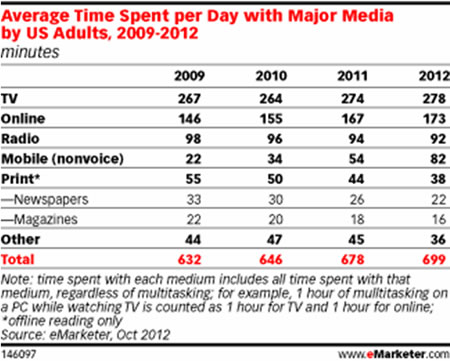I have been amused by some of the analyses I’m reading in the trades lately about how radio’s TSL is slipping and the culprit is….(drum roll)…mobile phones! The most recent was Inside Radio’s big headline “Mobile cuts into radio’s TSL.”
Maybe we should ask the NAB to see what they can do to convince the consumer electronics industry to slow down the sales of iPhones and Galaxy S IIIs this Christmas. Or maybe we should just urge radio broadcasters to simply stay away from those nasty smartphones because of their alleged erosive qualities.
 I’m wondering if this TSL slippage just might have more to do with all the new entertainment options that consumers have before their eyes and ears. Mobile is simply a delivery mechanism, but the real story is about all the different content choices that are available, and the fact they can be accessed just about anywhere and anytime.
I’m wondering if this TSL slippage just might have more to do with all the new entertainment options that consumers have before their eyes and ears. Mobile is simply a delivery mechanism, but the real story is about all the different content choices that are available, and the fact they can be accessed just about anywhere and anytime.
So maybe instead of sounding defensive or even close-minded, we should instead be encouraging radio to move even faster to take advantage of the mobile opportunity and actively participate in it.
The smartest minds in radio agree, from Bob Pittman, who has invested heavily in the iHeartRadio platform to the heads of just about every broadcast company. They are planning and strategizing with the future in mind. Are they crazy or do they see the incredible importance of mobile in consumers’ lives?
With so many of the media and technology advances of the past 10 years, broadcasters have had to sit on the sidelines…and stew. iPods, satellite radio, and other innovations cut broadcast radio out of the equation, often eroding AM and FM listening.
Mobile is just the opposite – an inclusive revolution that invites anyone with great content and a modicum of creativity to participate. There is no more democratic space than mobile, and oh yes, it’s the hottest thing going.
And did I mention that smartphones are the conduit that takes consumer infotainment into cars? Ask every major automaker. That’s why we continue to research the automotive space because the lion’s share of radio listening not only takes place on four wheels, but last time I checked, the top advertising category for most stations is…cars and car dealerships.
Readers of this blog and Jacobs Media clients are very aware of the “digital dashboard” movement, a topic that we’ll explore in depth at the Arbitron Client Conference in Annapolis this December. I have video footage from some of the key automakers that will motivate broadcasters to clean up their streams and take a more aggressive approach. No one will consider stopping streaming as a solution once you’ve seen these clips.
Earlier this week, RAIN published the following chart from eMarketer that says it all about the trajectory of media usage. Everyone is being impacted by the mobile revolution – but of course, everyone can also have a co-starring role in it. All things considered, radio is down, but still in the low 90 minute range for average TSL per day:
That mobile revenue has lagged is a fact. eMarketer also reports that while mobile now constitutes nearly 12% of a consumer’s overall media time, it is only returning <2% of advertising dollars.
Facebook and Google share in the frustration, but they also realize that when you’re dealing with the Wild West, it takes time for it all to get sorted out. As I explain every time I present Techsurvey8, when the big elephants figure it out (and recent Facebook financial data indicates they’re making progress), we will all benefit from new-found mobile revenue opportunities.
That is, if we choose to play, and play enthusiastically. This is another of those moments in time when broadcasters (and all global business sectors) have to take a look at the space and determine how they can benefit and play a role. Radio has a chance to occupy some incredible beachfront property on the desktops of smartphones and tablets – in homes, in offices, and in cars.
This is not the time to whine, deny, and turn away from the most amazing devices of our lifetimes.
And by the way. When was the last time you saw someone buy a radio? But walk by an Apple Store at any hour of the day, and they’re lined up to buy the latest release. And it’s probably been a while since you’ve seen a TV commercial for a radio station. But turn on any television show and wait no longer than 10 minutes to see advertising for a mobile phone, tablet, computer, or a search engine.
This is a tech tidal wave and the good news is that broadcasters are welcome.
Jump in.
- What To Do If Your Radio Station Goes Through A Midlife Crisis - April 25, 2025
- A 2020 Lesson?It Could All Be Gone In A Flash - April 24, 2025
- How AI Can Give Radio Personalities More…PERSONALITY - April 23, 2025





Hmmm. While I agree with everything you said, what was left out is the 800 lb gorilla – streaming royalties. Radio’s core product is audio, one of mobile’s key assets is personalization. That translates to personalized audio for radio, which it can’t do profitably.
Radio has made some valiant efforts to get involved with mobile – but even apps like I Heart Radio are more of a pencil reinvention than a game changer. Let’s face is, streaming terrestrial radio is still a clunky repurposing of existing content.
Everyone seems to think that the monetization thing will work it self out on mobile – but until the royalty rates change in a major way, radio will be forced to mostly sit on the sidelines while other media rack up interest, eyeballs and ears.
This is a critical, life changing issue for radio. It dwarfs whether this year is up 1 or 2 percent, whether phones activate their radio chips, whether radio “does a better job of selling its benefits” or any other issue that people write about in columns.
Mobile is the future and the car dashboard is on its way to being media neutral. What’s radio’s best case scenario when that happens with royalty rates unchanged?
I think Tim Westergren, Bob Pittman, and others are all over this, Bob. You raise great points about barriers, as do others about mobile’s erosive potential in ratings. But the paramount issue is whether broadcassters truly commit to making their content available wherever consumers have moved. The devil is in the details but consumers are on these devices and platforms. Radio must be, too. Thanks for the comment.
I must respectfully but completely disagree. All over it…I don’t think so.
Tim Westergren has done a masterful job of being quoted in media blogs, but this will not be won on wordpress or by anyone’s PR arm. When Pandora sells piles of shares to pay for lobbyists, then they can be characterized as all over it. When their CEO cites is as their main issue in analyst conference calls, that will be the signal that they are all over it. When they start running ads laying out the scenario to their user base, then they can be said to be all over it.
Bob Pittman all over it? When he spends more on this issue than iHeart Radio parties, he’s all over it. When all of his stations run something twice an hour skewering the current system and the labels for insisting on it, then you’ll know that he’s all over it. When this issue becomes CC’s single biggest lobbying priority and they approach it as if the future of the medium depends on major change here, then you can say that Bob Pittman is all over it. And remember, those rates go up every year and compound…and not by a percent or two. Every year this issue is not addressed the amount of adjustment necessary for survival increases.
Radio has done a wonderful, perhaps masterful job of maintaining most of its listening hours in the face of an onslaught of competition. But there are limits to how far the terrestrial signal and its online repurposing can go. Just making current content ubiquitous won’t be sufficient. Radio needs to be free to develop custom, personalized products in a way that can be monetized or that media neutral dash will start taking bigger and bigger bites out of its TSL.
Nobody is all over it and every day, every rate increase only makes the job progressively harder.
I have said this before but I think it bears being repeated: Is radio a delivery platform or a brand product?
If a delivery platform then they should fear the mobile phone as that means mobile can do nothing but hurt as it represents another choice in the already cluttered media-mix.
If it is an actual brand, then it should welcome mobile as another opportunity to touch their fans and be a part of their lives beyond the car.
The ability to manifest your station’s brand (mobile, social, etc) in so many different ways should be a very exciting prospect for some stations.
Agree completely, Jacquelyn. Radio stations and companies are in the media brand building business. I always shake my heads when I hear stations talk about increasing cume or extending time spent listening. If they’re building great brands, these issues take care of themselves. Thanks for pointing out the distinction, and thanks for reading our blog.
Kudos, Fred. Good post. The future belongs to those who respect and embrace the brave new world of 5 billion people walking around with a super-computer in their pocket/handbag.
Dave, thanks for weighing in. It’s an exciting time and a wide open opportunity to be successful in the mobile space. (Yes, written on my iPhone.)